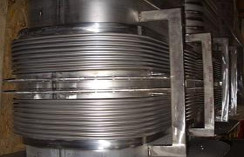
Whether you are a skilled professional or just a curious individual searching for information on metal expansion joints; such as what they are, how they work and for what situations they have been developed for, then you are definitely at the right place.
The following brief article will bring you up to speed with everything you need to know about these awesome products.
Metallic Expansion Joints – What are they?
Metallic expansion joints, also known as compensators are single or double walled expansion joints that allow relative movement and thermal expansion in pipelines, machines or containers. They are differentiated according to three different basic types of movements: angular, axial and lateral expansion joints.
The lateral expansion joints – These joints are used when motion of the two ends stay parallel to each other.
The Axial expansion joints – Axial is used either for stretching or flattening the expansion joints along their length.
The angular expansion joint – Angular movement is the curving of the joint along its axis.
Today, expansion joints have been designed to cope with the above three specific stress types. However, the only type of movement which they cannot deal with is torsion (twisting along the joints length). Fortunately, you can avoid this by keeping the joints fastened using external attachments.
What do they do?
The expansion joints are designed to sponge up and reduce the effects of directional change. This minimizes issues like clogging, expansion of joints or pressure points on the bend that arise from directional change. The basic science used on these products was developed from the joint expansion ideas used in installation of rails. The basic concept to put in mind is when metals are subjected to force (either from pressure or heat), they tend to expand and bend rather than breaking.
Where this technology used?
This technology was generally used for fluid management. However, there are many industries employing this technology today. These industries include the petrochemical industry, nuclear power industry, waste management, medical technology, altitude sensors and piping industrial coolants.
What amount of heat can compensators withstand?
The amount of heat that they can withstand depends on several factors such as the alloy chosen (whether or not any anti-corrosives agents are added), its design and whether it is shaped or welded. In addition, it is important to note that there are more physical limits to their use. But if the heat quantity is foreseen, there will always be a joint solution.
Advantages of expansion joints
1.Has higher pressure range: up to PN 1002.
2.Has higher temperature range: up to 1000 C3.
3.Besides fluids and gases they are also suitable for abrasive media and solids4.
4.Has flexible connection types*has flexible extension possibilities
Disadvantages of expansion joints
1. Restricted suitability with many acids
2. Only partly suitable for oscillations
3. Relatively large construction lengths (e. g. with lateral expansion joints)
4. Particularly at high pressures, construction with high spring rates is required
Well that is all you need to know about compensators. I hope the information has been of great use.


Leave a Reply